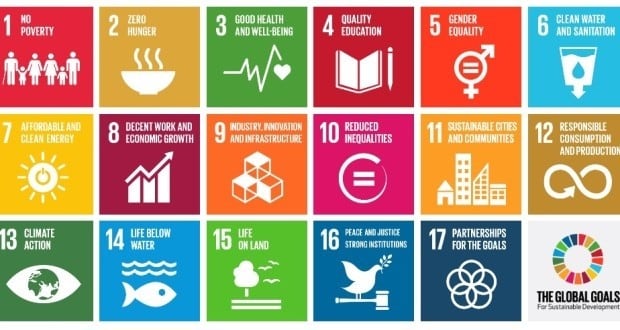In the second part of our exclusive interview with the company’s Nutritional Products President and CEO Chris Goppelsroeder, we drilled down on all matters related to sustainability in light of DSM’s belief that it is well equipped to contribute to five of the UN’s Sustainable Development Goals (SDGs).
These are the commitments spanning zero hunger, good health and wellbeing, affordable and clean energy, climate action and responsible consumption and production.
Earlier this year, the company announced that it had committed to reducing 30% of its greenhouse gas emissions from direct production and purchased energy in absolute terms by 2030 compared to 2016.

Crucially, Goppelsroeder told us that this had been embedded in the firm’s financial and incentive structures.
“We now go as far as to charge internally for the for our CO2 footprint,” he said. “My business gets charged €50 per tonne of emissions, which is far higher than the market average. The upshot of this is that if I make progress, it is better for our bottom line.”
Staying on the themes of clean energy and climate change, he highlighted the company’s new biomass co-generation facility at its vitamin production site in Switzerland, which will cut 50,000 tonnes of Co2 emissions each year, and the expansion of its Belvidere solar field in New Jersey, US, which will offset more than 17,400 tonnes of emissions annually.
China gains
In the APAC region, however, China has been the main focus for the company’s environmental efforts in recent years, with Goppelsroeder emphasising the “phenomenal pace of change” in the government’s attitude towards sustainability.
In 2015, DSM acquired Aland, a Hong Kong-based company producing vitamin C in Jingjiang, Jiangsu Province in mainland China.
Since then, the firm has completed a series of measures to improve product quality, workers’ safety, and to lower its carbon footprint by slashing its coal reliance, and has pledged to use only natural gas in the next three years.
“In the last few years, the focus on sustainability from the Chinese government, and others in the country, has changed the landscape significantly,” he said.
“Back in 2015 I was talking to the government about the quality of the entire enterprise in Jingjiang, and not just the quality of the product, which I think was a surprise to them.
“But now they are talking the same language and are appreciative that we focused on sustainability early on, even if they did not so much at the time. This shows the rate of change is supremely fast.”
However, while reducing energy use and cutting carbon emissions is crucial, Goppeslroeder said it was only one piece of the jigsaw if the SDGs were to be achieved by 2030.
“We not only have to do less by reducing our footprint, but we must also do things differently. Yes, we need to reduce, but we also need to enable change and advocate for it.
“That’s why we spends tonnes of money in innovation, and 80% of it goes towards products that are fully about sustainability,” he said.
The challenge, her however, is to marry the need for sustainability with business reality.
As Goopeslroeder puts it, governments can’t achieve the SDGs alone, but business can’t play their part if the outcomes aren’t attractive to the market.
“We are working very hard to find areas where we can innovate in a sustainable way, but also where people in the market value it enough to then put their money down,” he added.
One example that had hit the sweet spot of boosting sustainability while also being attractive to DSMs customers and their consumers, is a natural marine algae for salmon feed.
This allows the production of omega-3 fatty acids via a fermentation process without using wild caught fish.
The development, a joint venture with Evonik, has an annual production capacity to meet roughly 15% of the total current annual demand for EPA and DHA by the salmon aquaculture industry.
“This is not a cheaper solution for customers, its more expensive, but not outrageously so,” he told us.
“And people actually want it for that reason,’ he added, “because this project enables our customers to tell their consumers that their salmon is sustainable.”
India project
In the nutrition space, here in the APAC region, Goppeslroder said the company was playing its role towards the zero hunger, good health and wellbeing, and responsible consumption targets at both ends of the pyramid.
While the region still has around 800m people who are undernourished, there are growing problems with obesity and diabetes, and he argued that there needed to long-term projects to alleviate both.
“We need governments to act, both around fortification and reformulation, and we need businesses to commit. We don’t change the projects we work on in these areas every year – we need to stick with them. If you change every year, you will never make an impact.”
One example, he added, was the MANDI project - Making A Nutrition Difference to India.
This is a socio-commercial business delivering fortified food and staple products, such as rice and lentils, as well as vitamin and mineral supplements.
It stemmed from a need to help the large section of the population that was “just above those at the bottom of the pyramid”.
“Those at the very bottom were often getting support, so we worked closely with others to propose fortification of staple foods in a much stronger way to the government.
“This was to help the large number of people who are a little higher up, but still lack adequate means,” added Goppesroeder.
“This has had a lot of benefits, especially with rice fortification, because we managed to find a solution that maintained the taste, size and shape, while containing quite a large amount of vitamin A.”
At the other end of the scale, there is the challenge of obesity and diabetes. And here Goppeslroeder sees a big opportunity for reformulation, supplementation and, ultimately, personalisation.
“This needs multiple actions from governments and business to change behavior,” he added.
In the first part of this feature, he emphasised how he believed personalisation would be the future of dietary supplements, but added no single firm had yet found the right way to test consumers, effectively communicate results, and deliver solutions in a palatable format that avoided the need to take multiple pills.
“This brings us back to innovation,” he added.
“We are investing heavily in personalisation because we believe it can help meet some of the challenges we see around obesity, diabetes and micronutrient intake.
“This will first take off among those can afford it, but eventually it will be accessible to everyone and benefit everyone,” he concluded.


